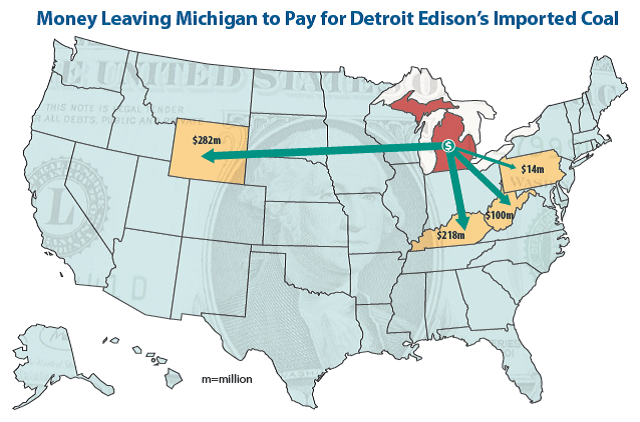 |
| That's probably a DTE coal plant in the background. |
 |
| Fun Fact: "Renewables" is mostly burning gas from cow shit and trash. Seriously. |
As you can see, we use a disproportionately coal-heavy mix in this area when it comes to power generation. And that's not clean-coal, either. More than a third of all our coal plants were built over 50 years ago, and 87% of our coal burning capacity exceeds the typical 30-year design of a coal powerplant. Further, Michigan has no reserves of its own, so all that coal must be shipped in from elsewhere at great cost. Gas and Nuclear account for a smaller portion of our mix, and renewable energy sources account for very little of the whole. You might be able to imagine what that means for pollution, but let's get a visual anyways.
 |
| Clicking embiggens. |
Carbon Dioxide and Nitrogen Oxide emissions are meaningfully higher than the national average, and Sulfur Dioxide is more than twice the national average. While it's not a potent greenhouse gas, SO2 is known to be particularly harmful to the respiratory system, and contributes to acid rain. As an aside, "Sulpher?" Seriously, EPA?
What does this mean to the Electric Car driver? There's a lot to parse out here. Let's start with that lovable greenhouse gas, CO2. Compared to the conventionally-engined Nissan Versa, the Leaf would still only generate a little more than half the CO2 over the course of a year - 4.1 tons versus about 2.4 tons for the Leaf. Obviously, a cleaner energy mix would improve that figure even more.
Sulphurfurpher dioxide isn't really an issue for gas-powered cars, except for those powered by diesel. I can't really find any published data on the tailpipe emissions of sulfur dioxide and nitrogen oxides in passenger cars, so we can't directly compare. Sorry, asthmatics.
Finally, what about making that large battery pack? Isn't that pollution-intensive, and shouldn't we count that in the final tally? Recently, the Nissan Leaf was named lowest total carbon footprint by the Automotive Science Group, and the data they ran included looking at the production of the car and battery itself.
In the end, the data means two things to me.
1) DTE energy can and should do a better job of diversifying its energy source mix, looking towards renewables like wind and solar to keep emissions down. It's not as if Michigan isn't a good state for alternative energy generation.
2) Even with Old Smoky DTE supplying the juice, the electric car is still a cleaner mode of transportation than burning gasoline.



1.) Every time I scroll past this post I think your car is farting smoke.
ReplyDelete2.) I think the Prius C is cute. Thoughts?
1) that is ridiculous.
Delete2) I agree it's a cute car. I don't know if I would consider it given the strong less-expensive competitors in the segment - Honda Fit, Ford Fiesta, and Nissan Versa among many others.